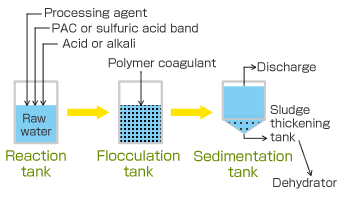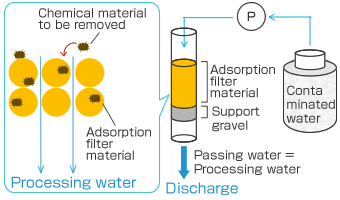What are water pollution countermeasures?
Water pollution is a high-risk where there is a high possibility of environmental impact as well as health hazards due to pollution. To offer not simply comfort but a higher level of security, AMEC’s proposals to our clients aim at “reliable and complete purification.”
- The standard for water pollution has been made steadily stricter over the years. In response to the demands of the times, AMEC proposes solutions to enable the purification of water in the cases where conventional techniques could not meet our customers’ requirements.
- AMEC’s techniques can offer simple and high-performance treatment using an adsorbent with high adsorption ability for heavy metals.
- CAMZ and CAMZ-W developed by AMEC have specific shapes with an advantage in permeability and allow for treatment by the rapid filtration method, which has high treatment efficiency. Because continuous treatment is also possible, the purification equipment can be very compact compared with that of the flocculation–sedimentation method.
- AMEC performs its own validation using real contaminated water and proposes the most suitable products and treatment processes. Safe and effective advanced treatment can be realized, including a combined application with existing treatment facilities.
Specific examples of AMEC’s solutions
The following is a list of products and methods aimed for different pollution situations:

- Target / Amount
- Factory effluent 60m³
- Contaminant concentration:
- Arsenic (As) 0.01~ 0.1mg/L
- Situation:
- It was not necessary to comply to the effluent standard, but rather the environmental standard.
- Methods and materials:
- CAMZ for adsorption filtering treatment of effluent CAMZ
- Reasons why AMEC was chosen:
- It was possible to reduce the concentration to the detection limit. Replacing the existing facility was a simple task.
- Achievements:
- Adopted for effluent treatment at a factory in Chubu District.

- Target / Amount
- Groundwater 200m³
- Contaminant concentration:
- Arsenic (As) 0.026mg/L
- Situation:
- Arsenic over the environmental standard was detected in a simple water-supply system being planned for the use of groundwater.
- Methods and materials:
- CAMZ for adsorption filtering treatment of drinking water CAMZ
- Reasons why AMEC was chosen:
- Using compact equipment, we achieved continuous treatment in a limited installation space.
- Achievements:
- Adopted for securing an independent water source for a lodging facility in Tohoku District.

- Target / Amount
- Factory effluent 120m³/day
- Contaminant concentration:
- Arsenic (As)
0.1~0.2mg/L
Selenium (Se)
0.1~0.2mg/L - Situation:
- It was necessary to reduce the combined pollution of arsenic and selenium down to less than the environmental standard.
- Methods and materials:
- CAMZ for adsorption filtering treatment of effluent CAMZ
- Reasons why AMEC was chosen:
- One type of adsorbent acts simultaneously on arsenic and selenium in the case of combined pollution.
- Achievements:
- Adopted for the effluent treatment of a metal smelting factory in Kansai district.

- Target / Amount
- Mine spring water (not available)
- Contaminant concentration:
- Selenium (Se) 0.126mg/L
- Situation:
- Spring water was found at a contaminated soil storage site.
- Methods and materials:
- Flocculation and sedimentation, TKS105
- Reasons why AMEC was chosen:
- A small amount of additive exhibits an effect for selenium, which is normally difficult to adsorb.
- Achievements:
- Adopted for treating spring water in the mountainous area of Kinki district.

- Target / Amount
- Groundwater 24m³/day
- Contaminant concentration:
- Arsenic (As) 0.177mg/L
- Situation:
- It was necessary to only remove arsenic without spoiling the water quality characteristic to the area.
- Methods and materials:
- CAMZ for adsorption filtering treatment of drinking water CAMZ
- Reasons why AMEC was chosen:
- Arsenic can be removed selectively by using an adsorption material that has selectivity for different materials.
- Achievements:
- Adopted for treating spring water in Kanto district.
- ※Above pictures are sample photos.
Description of construction methods
~ methods for water pollution countermeasures ~
Using adsorption materials that are effective for soluble heavy metals, AMEC’s treatment can remove contaminants to a non-detection level.
We propose the most suitable treatment method using the flocculation–sedimentation method or the adsorption filtration method, considering the concentration and conditions of contamination and the design of the treatment facility.
AMEC’s countermeasures according to the type of problem:
-
The adsorbent developed by AMEC has strong adsorption capacity, and the contaminants can be lowered from the low concentration level to a non-detection level.
Anyone can perform the treatment easily and safely without using special operations. -
Installation of compact treatment equipment is possible without requiring a large-capacity reaction tank.
Continuous treatment can be realized by removing pollutants via instantaneous chemisorption. -
Parallel use with existing effluent treatment equipment is easy because mere contact with contaminated water exhibits an effect. Treatment at lower concentrations is possible by installing an adsorption filtration tower after the coagulation treatment equipment.
-
Because the adsorbent developed by AMEC is composed primarily of inorganic compounds, it can be used without the risk of age deterioration. Emergencies can be dealt with by placing the adsorbent in the terminal portion of the effluent flow.
-
Total treatment of severely contaminated water is achieved by the combined use of the flocculation–sedimentation method and the adsorption filtration method.
Description of treatment methods
Flocculation sedimentation method

- Summary:
- By adding and mixing coagulant chemicals in a reaction tank filled with contaminated water, flocculation occurs and removes suspended solids and colloidal particles after a certain period of time. After sedimentation is complete, supernatant fluid is discharged. The deposited sediment goes through a dehydration and drying process and is then treated as sludge. If the sedimentation rate is slow, precipitating agents may be added.
- Special features:
- Effective for medium- and high-concentration contaminated water.
Many treatment steps.
Reaction and sedimentation require more time.
Precipitates and sludge must be collected and treated.
Adsorption filtration method

- Summary:
- By letting the contaminated water pass through a material with a constant particle size, porosity, and adsorption characteristics, the pollutants are removed from the contaminated water. There are physical and chemical adsorption methods. They take effect merely by coming in contact with the contaminated water, and a simple and continuous treatment is therefore possible.
- Special features:
- Low-concentration contamination can be reduced to a non-detection level.
Few treatment steps.
Continuous treatment is possible.
Precipitates and sludge are not formed.
Comparison between widely used arsenic adsorbents and AMEC’s products
Cerium-based
- Summary:
- The granular adsorbent supporting cerium hydroxide removes arsenic by the ion effect of hydroxyl ions.
- Performance:
- ◯
- Stability after adsorption:
- ×
- Conditions of storage and use:
- ×
- Cost:
- △
Alumina-based
- Summary:
- Arsenic is removed by chemisorption to the surface of the granular adsorbent, which is composed of aluminum oxide and supports cerium hydroxide.
- Performance:
- △
- Stability after adsorption:
- △
- Conditions of storage and use:
- ◯
- Cost:
- △
Iron powder-based
- Summary:
- Metallic iron powder adsorbent; arsenic is removed by the formation of iron arsenate by arsenic binding of the iron ions and the arsenic ions.
- Performance:
- △
- Stability after adsorption:
- △
- Conditions of storage and use:
- △
- Cost:
- ◯
CAMZ(AMEC’s products)
- Summary:
- Arsenic is removed by means of adsorption by ion exchange using a granular adsorbent composed of a complex material of artificial zeolite and iron compounds.
- Performance:
- ◯
- Stability after adsorption:
- ◯
- Conditions of storage and use:
- ◯
- Cost:
- △
Steps toward the solution of the problem
AMEC’s sales representatives and engineers brainstorm in consultation with the customer until a satisfactory solution is reached.
- 1Emergence of a problem
- Do not hesitate to contact AMEC when in urgent need of pollution countermeasures.
- 2Diagnosis
- A sales representative and an engineer are specislly assigned to each cutomer;they are responsible for helping thecustomer to solve the problem.
- 3Vaidation
- They examine the on-site and surrounding environment and take note of the customer's problems.
- 4Planning
- AMEC's engineers work together to find the best suitable solution and draw up a plan.
- 5Solution to the problem
- We make every effort to not only clean up the pollution but also ease the customer's concerns.
